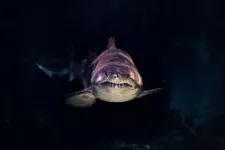Peterman, Ritterbush and their colleagues took 3-D printed reconstructions of fossil cephalopods to actual water tanks (including a University of Utah swimming pool) to see how their shell structure may have been tied to their movement and lifestyle. Their research is published in PeerJ and in an upcoming memorial volume to the late paleontologist William Cobban. They found that cephalopods with straight shells called orthocones likely lived a vertical life, jetting up and down to catch food and evade predators. Others with spiral shells, called torticones, added a gentle spin to their vertical motions.
"Thanks to these novel techniques," says Peterman, a postdoctoral scholar in the Department of Geology and Geophysics, "we can trudge into a largely unexplored frontier in paleobiology. Through detailed modeling, these techniques help paint a clearer picture of the capabilities of these ecologically significant animals while they were alive."
The researchers are veterans of this style of "virtual paleontology," having worked with digital ammonoid models and 3-D printed versions to test hypotheses about their evolution and lifestyles. Most ammonoids have coiled shells, like today's chambered nautilus, and darted around the ocean in all directions.
But in their researcher published in PeerJ, Peterman and Ritterbush, assistant professor of Geology & Geophysics, explored a different shell shape--the straight-shelled orthocone. Straight shells evolved several times in different lineages throughout the fossil record, suggesting they had some adaptive value.
"This is important because orthocones span a huge chunk of time and are represented by hundreds of genera [plural of genus]," Peterman says, and many reconstructions and dioramas show orthocones as horizontal swimmers like squid. "They were major components of marine ecosystems, yet we know very little about their swimming capabilities."
So he and Ritterbush took 3-D scans of fossils of Baculites compressus, an orthocone species that lived during the Cretaceous, and designed four different digital models, each with different physical properties. Find an orthocone digital model here.
How did they know how to weight the structures of the models? "Math," Peterman says. They adjusted the centers of mass and counterweights within the models, representing the balances of soft tissue and air-filled voids that the orthocone would likely have maintained in its life. "The resultant model is balanced the same as the living animal, allowing very detailed analyses of their movement," he says.
The resultant 3-D printed models were nearly two feet long. With the help of Emma Janusz and Mark Weiss at the U's George S. Eccles Student Life Center, the researchers set up a camera rig in a 7-foot-deep part of the Crimson Lagoon pool and released the models underwater to see how they naturally moved.
The results showed clearly that the most efficient method of movement was vertical, since moving side to side created a lot of drag. "I was surprised by how stable they are," Peterman says. "Any amount of rotation away from their vertical orientation is met with a strong restoring moment so many species of living orthocones were likely unable to modify their own orientations. Furthermore, the source of jet thrust is situated so low that, during lateral movement, much energy would be lost due to rocking."
The results also showed that orthocones may have been capable of high velocities among shelled cephalopods. That could have come in handy in evading predators. Looking at the results of the pool experiments and calculating the time needed to escape modern predators (as stand-ins for the orthocones' long-extinct predators), they found that orthocones may have been able to jet upward fast enough to evade animals similar to crocodiles or whales. They may not have been as lucky against fast swimmers like sharks, however.
So most species of orthocones couldn't have lived a horizonal-swimming lifestyle. "Instead," Peterman says, "species without counterweights in their shells assumed a vertical life habit, either feeding near the seafloor or vertically migrating in the water column. While orthocones were not as athletic or active as modern squid, they could have maintained the ability to thwart predators with upward dodges."
Peterman and Ritterbush, along with recent graduate Nicholas Hebdon and Ryan Shell from the Cincinnati Museum Center, also ran a similar set of experiments with torticones, smaller cephalopods with a corkscrew-shaped shell. The results will be published in the American Association of Petroleum Geologists and Wyoming Geological Association Special Volume - Insights into the Cretaceous: Building on the Legacy of William A. Cobban (1916-2015). Although the torticones also likely preferred vertical movement, their shape caused a different result in the water, Peterman says."While orthocones were masters of vertical movement, torticones were masters of rotation."
Many mollusks today have similar helical shells, and some researchers previously assumed that torticones may have had a similar lifestyle, crawling along the seafloor. "However," Peterman says, "the hydrostatic models demonstrate that the chambered shells of torticone ammonoids had the capacity for neutral buoyancy, which would have liberated them from the seafloor. These ammonoids experience different forms of movement only possible in a free-swimming lifestyle."
In experiments conducted in a 50-gallon water tank (no swimming pool needed for the 6-inch-long torticone models that are available digitally here) the team found that the torticones naturally and efficiently rotated in the water just due to the shape of the shell, gently spinning face-first when descending and spinning the opposite direction when ascending. Also, they found, the placement of the torticones' source of thrust relative to their center of mass would have improved the efficiency of active rotation.
Rotating while descending, Peterman says, may have helped the torticones feed, allowing them to graze on small planktonic organisms.
"I was surprised at how easily torticones could rotate," Peterman says. "Even small thrusts such as breathing [gill ventilation] could have produced rotation of 20 degrees per second."
Both orthocones and torticones, because of their repeated appearance throughout the fossil record, not only show that cephalopods found some advantage to a straight or helical shell, as opposed to their nautilus-shaped coiled shell, but that an uncoiled shell might have evolved in times of "ecological saturation," when the ecological niches of coiled cephalopods were full.
Peterman says this work calls for a revision of how we envision the ancient ocean.
"These experiments," he says, "transform our understanding of ancient ecosystems. Rather than crawling along the seafloor like snails, or swiftly swimming like modern squid, these animals were assuming rather unique lifestyles. These experiments refine our understanding of these animals by painting a picture of ancient seascapes dotted with pirouetting helical cephalopods and vertically-oriented orthocones."
INFORMATION:
Find the PeerJ study on orthocones here.
The Wyoming Geological Association Special Volume study on torticones is forthcoming.




